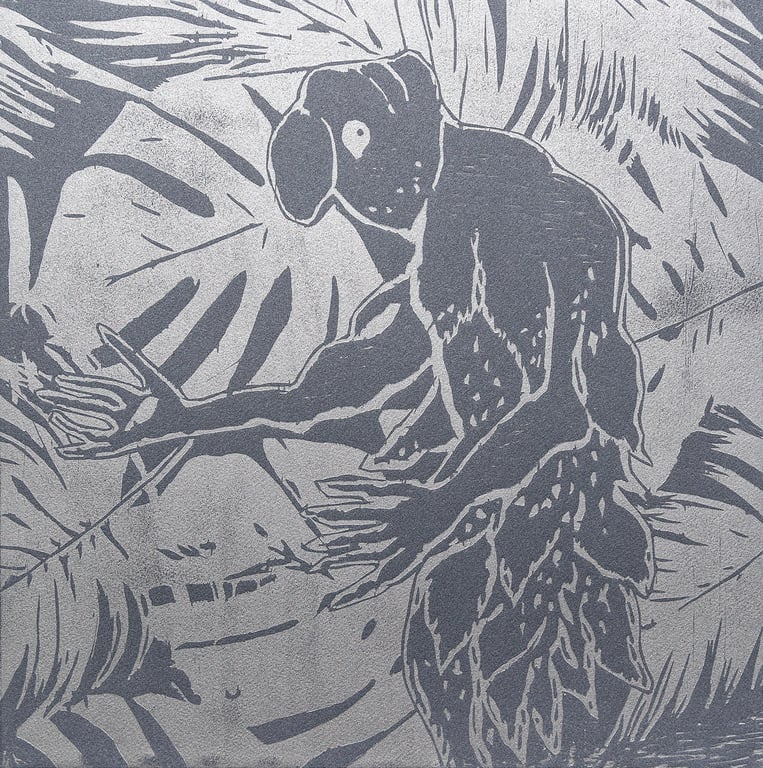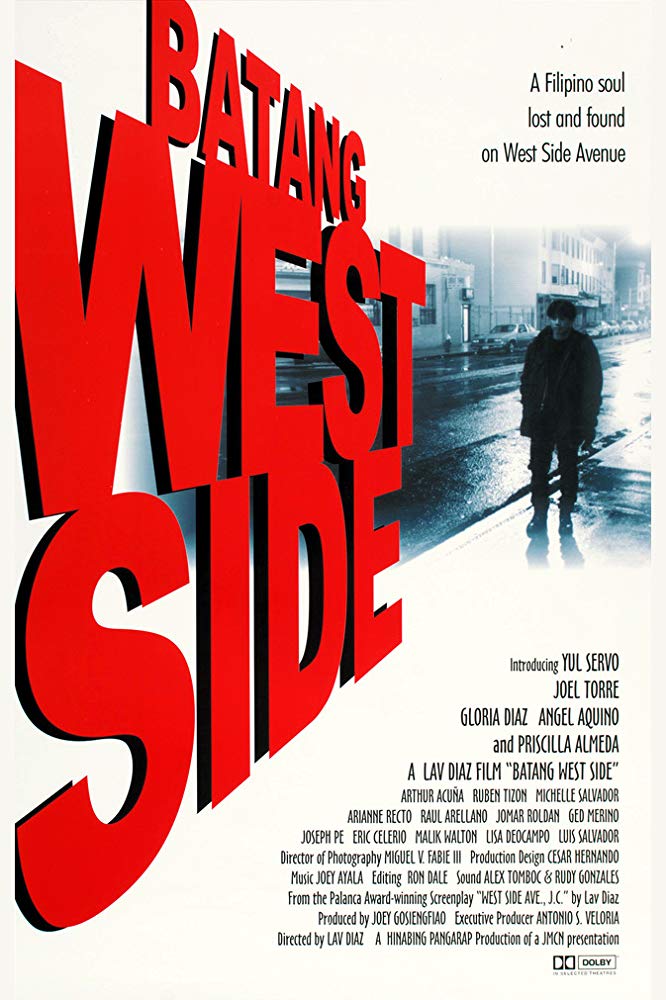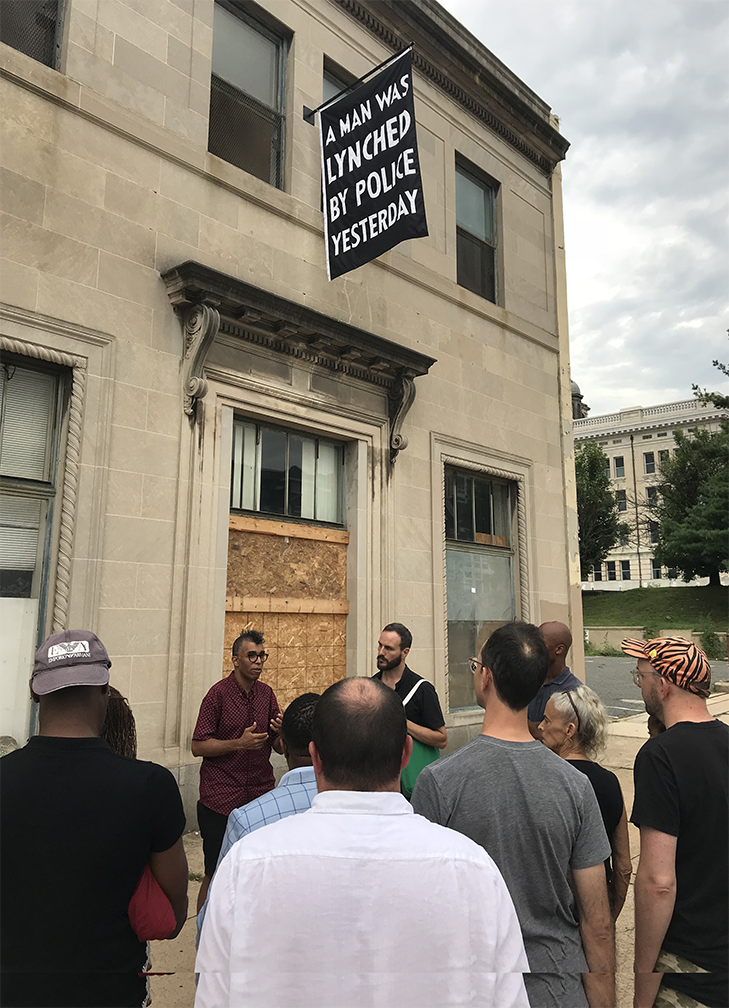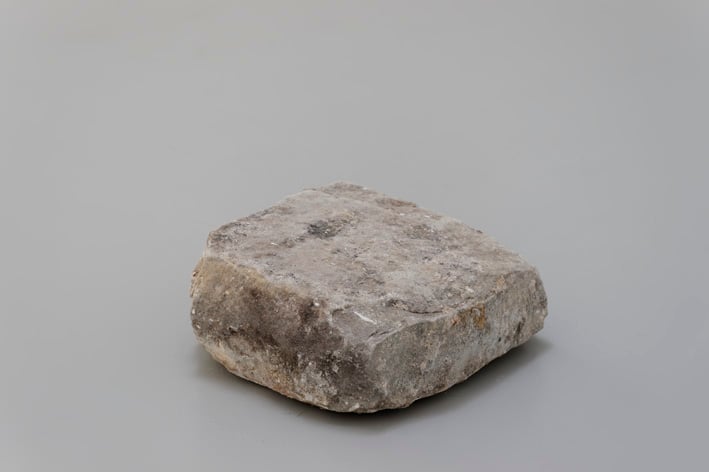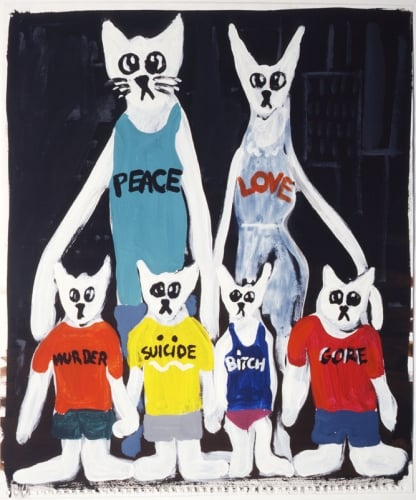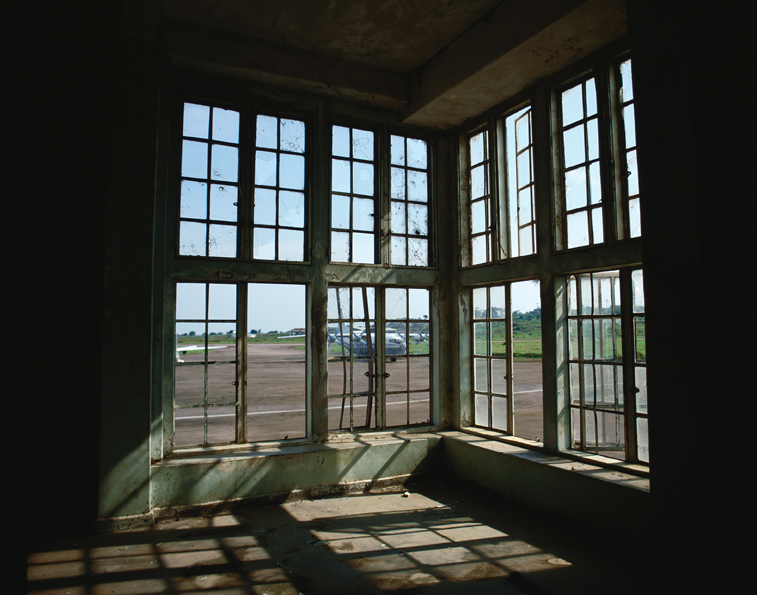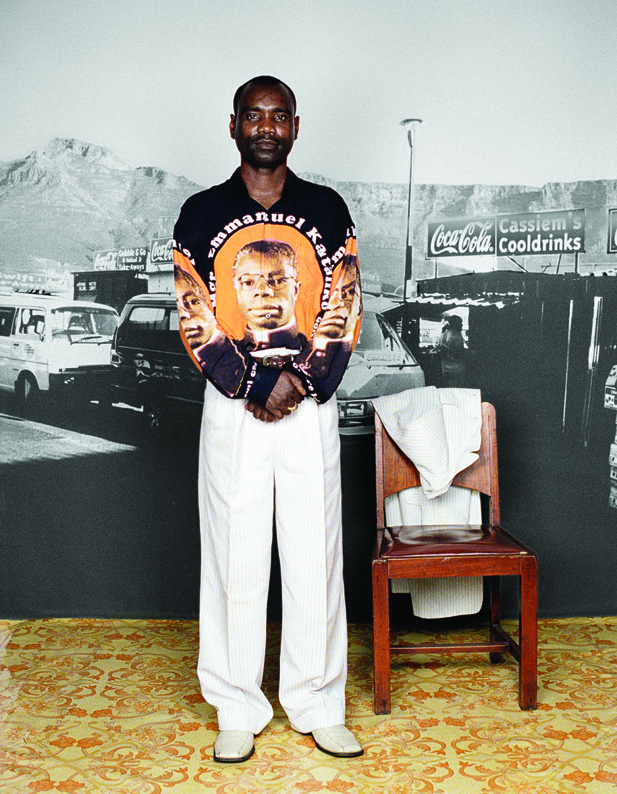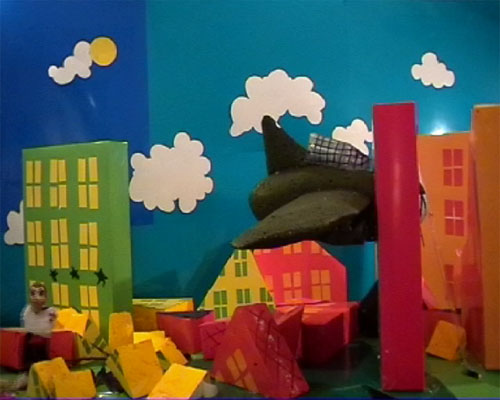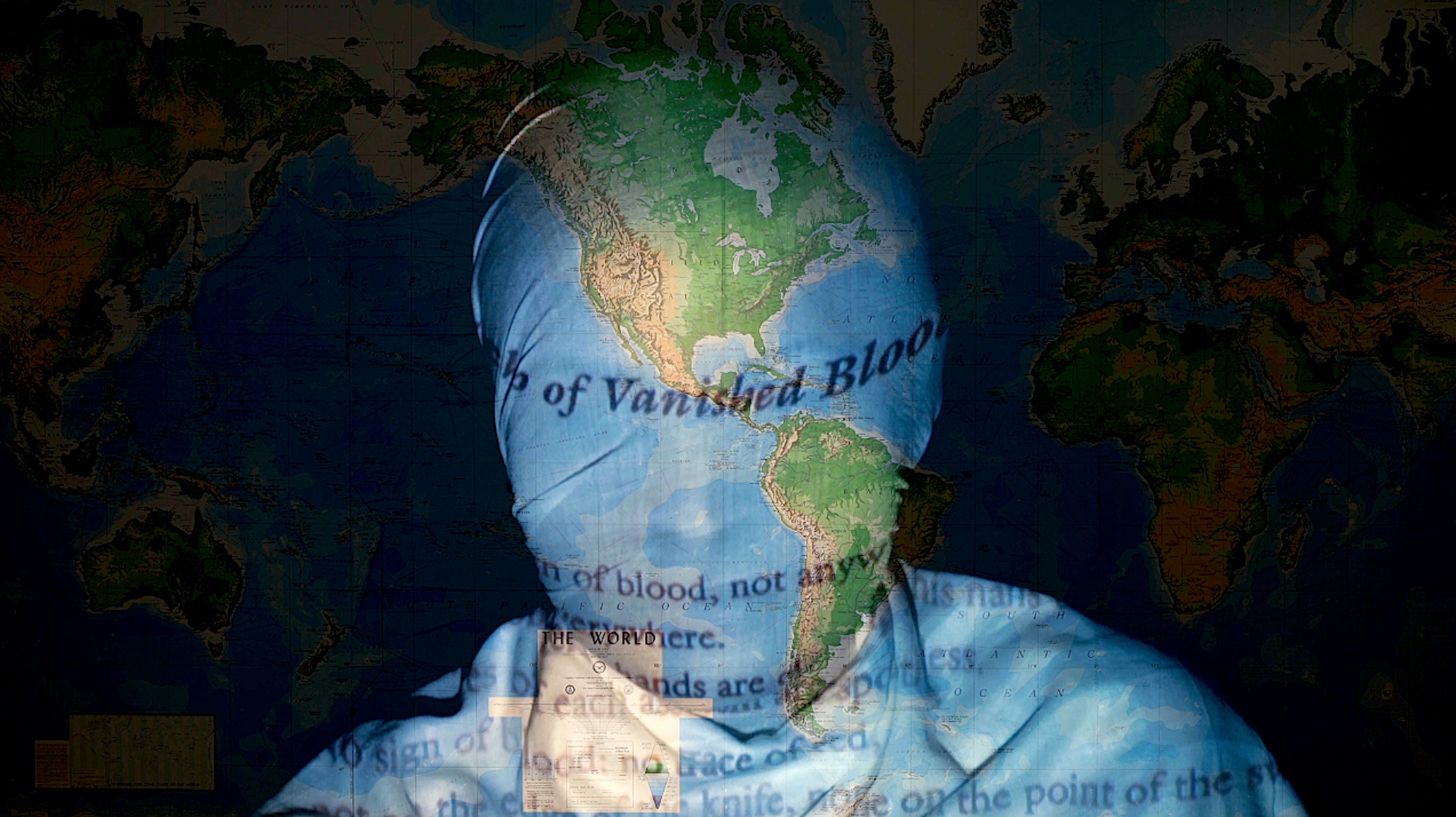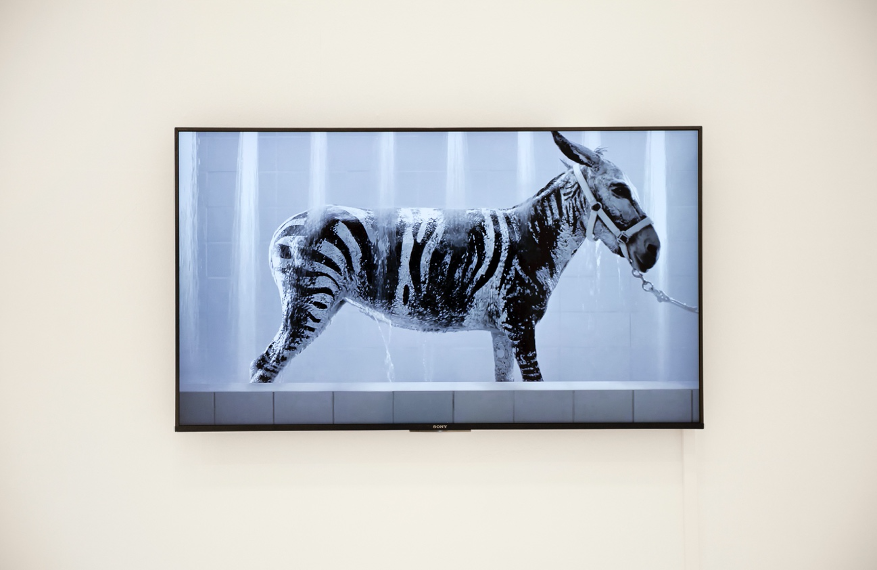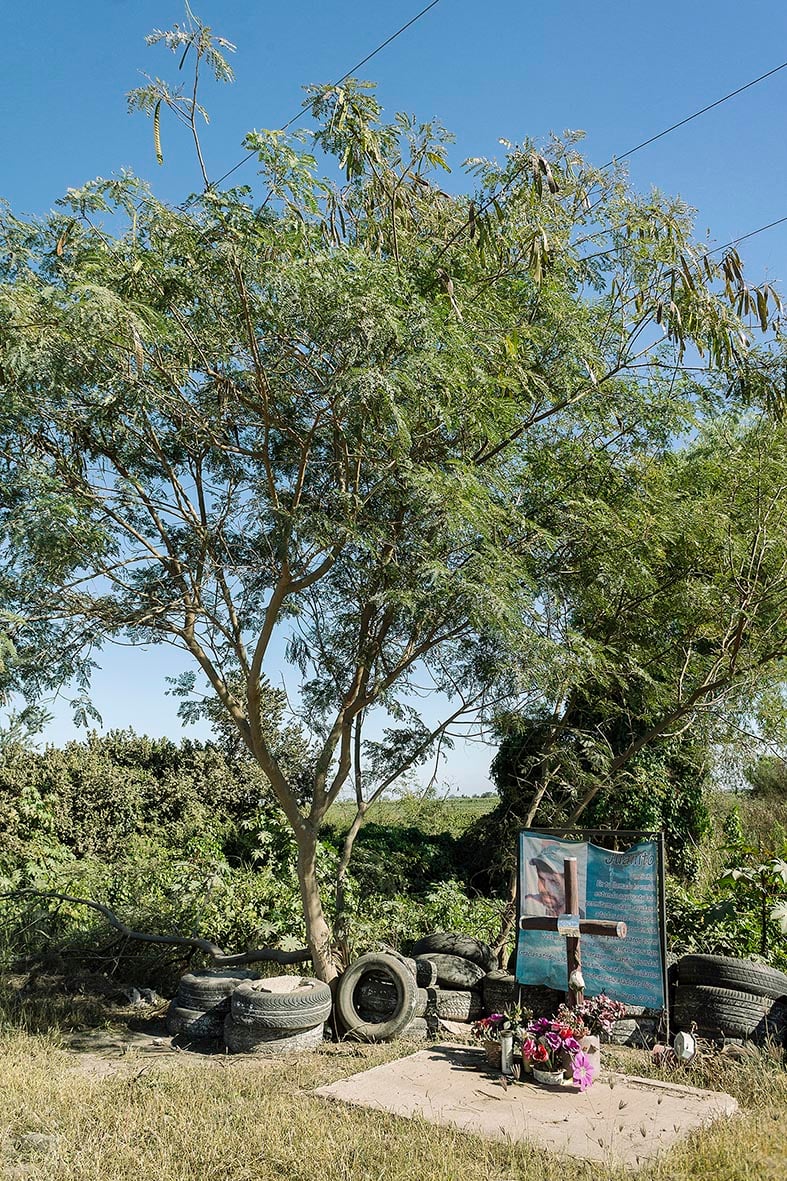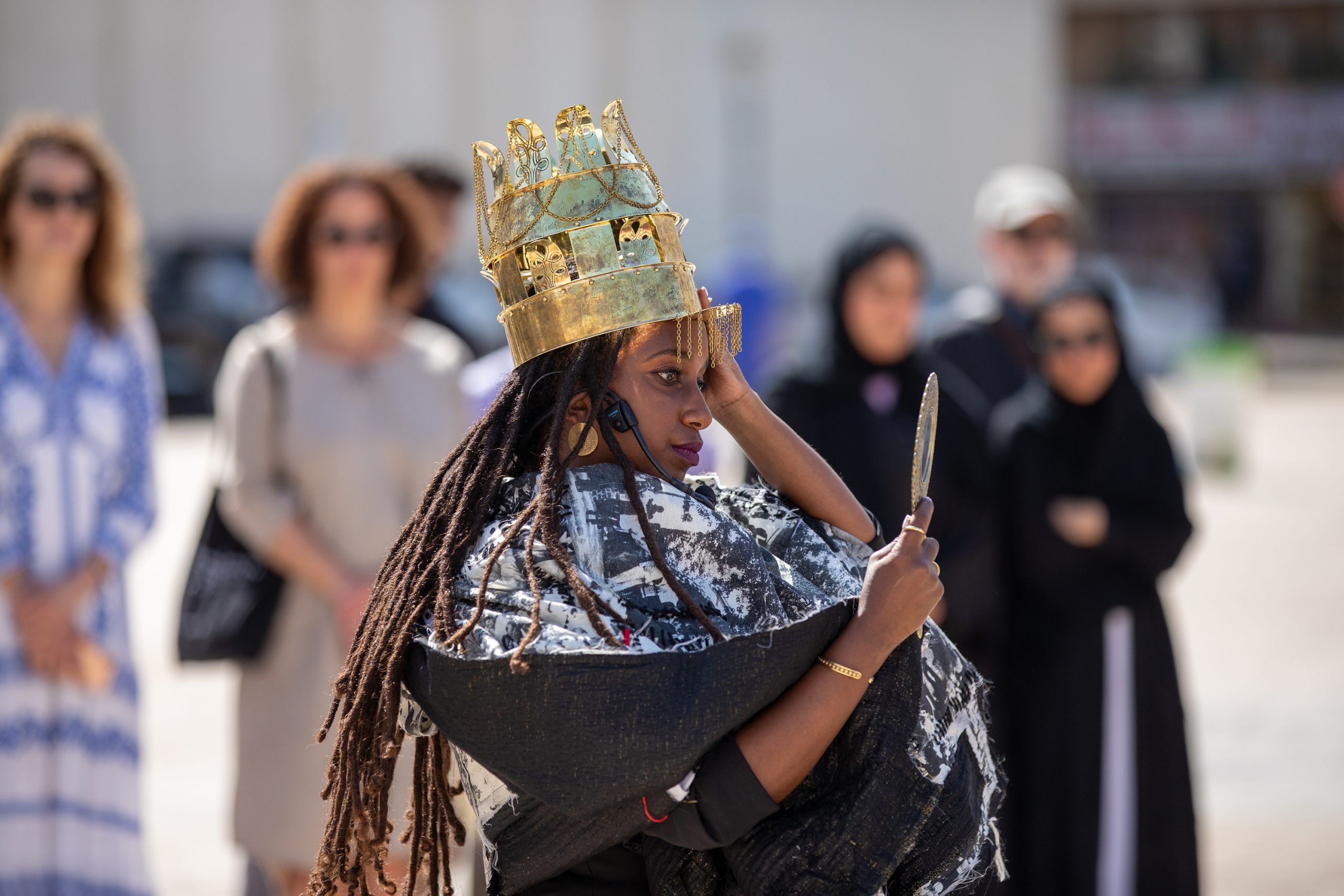
© » KADIST
Majd Abdel Hamid
Tadmur by artist Majd Abdel Hamid is influenced by a book by Mustafa Khalifa titled The Shell: Memoirs of a Hidden Observer , which details Khalifa’s imprisonment in the Assad ‘desert prison’ Tadmur. Khalifa’s compelling testimonial is now considered to have enlightened the Syrian public to the atrocities being committed in their country by the Assad regime and catalyzed a political resurgence in Syria. The prison was destroyed by ISIS in 2015 and though the initial reaction by the Syrian public was largely positive, the complete leveling of the prison erases the brutal experiences of the prisoners, many of whom died and those that survived.

© » KADIST
Prabhakar Kamble
To produce the series of sculptures collectively titled Utarand , Prabhakar Kamble relocated his studio to Kolhapur, Maharashtra, near the village where he was born into a family of daily wage earners. Kamble cast the feet of agricultural workers in metal to prop up the eponymous terracotta pots traditionally used to store food and grains in every home. A commentary on the caste system’s four-tiered hierarchy, the pots become smaller as they go up the stand, mimicking the structure of society where most of the population is comprised of impoverished communities, which form the base of the caste system while a small minority makes up the wealthy upper castes.

© » KADIST
Pichet Piaklin
The Wings by Pichet Piaklin is a creation story of fragility, where the desire for freedom is mired in blood red by the inculcation of faith and violence. Piaklin was born and continues to live and work in Thailand’s deep south, a geographical area once known as the Pattani Kingdom (now the Pattani, Yala, and Narathiwat provinces), before it was annexed by the Siam Kingdom in the early 1900s. As a consequence of unreconciled historical conflict, this predominantly Muslim community continues to endure oppressive social and political conditions under the ruling Thai Buddhist monarchy.

© » KADIST
Pratchaya Phinthong
Pratchaya Phinthong’s work has explored the mineral and karmic economies of Laos, a country that shares language, beliefs, and a long border with his own native region of Isaan (Northeast Thailand). The most bombed nation on earth, Laos still bears the physical and mental scars of the U. S. military’s epic aerial offensive, launched largely from bases in Isaan, during the Second Indochina War. Between 1964 and 1973 the US dropped an estimated 250 million cluster bombs on Laos.

© » KADIST
Emmanuel van der Auwera
Emmanuel van der Auwera visited Miami at the end of 2017 and was working on a project relating to school shootings. Two months later, on 14 February 2018, 19 year old Nicolas Cruz killed 17 people and injured 17 others in a shooting at the Marjory Stoneman Douglas High School in Parkland, Florida. Van de Auwera began to follow videos uploaded to the Periscope App, a live broadcasting channel that closed in March 2021, downloading them and creating a bank of data that would otherwise disappear, as material on Periscope was self-deleting after a short period of time.

© » KADIST
Kathy Jetnil-Kijiner
Anointed by Kathy Jetnil-Kijiner and Dan Lin is a poem recital/video that addresses the American nuclear testing legacy in the Marshall Islands that occurred between 1946 to 1958 in Bikini and Enewetak Atolls. The artist’s words of resilience and healing are uttered as she travels across the northeastern atolls of her vast island nation. The climax of the short film takes place when the artist, holding white coral stones (a Marshallese funeral ritual) stands on top of the massive concrete dome erected on Runit Island in Enewetak Atoll to contain 73,000 square meters of radioactive waste—only a small fraction of the debris generated by the nuclear tests, the rest of which was never cleaned up.
![Elevación [Elevation]](https://kadist.org/wp-content/uploads/2022/09/IMG_escena001_3513-scaled.jpg)
© » KADIST
Ana María Millán
Interested in role-play and videogames, Ana María Millán developed workshops with different communities in order to create characters and scenarios for her animations, often in collaboration with a choreographer. Elevación evokes various narratives inspired by the comicstrip Marquetalia, Raíces de la Resistencia (Marquetalia, Roots of the Resistance) (2011). This comic strip is a memoir of the FARC (Revolutionary Armed Forces of Colombia) guerillas written by Jesús Santrich, one of its leaders who, after the 2016 Peace Agreement, rejoined dissident members of the organization in a clandestine guerrilla splinter group in 2019.

© » KADIST
Prabhakar Kamble
To produce the series of sculptures collectively titled Utarand , Prabhakar Kamble relocated his studio to Kolhapur, Maharashtra, near the village where he was born into a family of daily wage earners. Kamble cast the feet of agricultural workers in metal to prop up the eponymous terracotta pots traditionally used to store food and grains in every home. A commentary on the caste system’s four-tiered hierarchy, the pots become smaller as they go up the stand, mimicking the structure of society where most of the population is comprised of impoverished communities, which form the base of the caste system while a small minority makes up the wealthy upper castes.

© » KADIST
Mona Marzouk
Trayvon is a series of acrylic paintings by Mona Marzouk that engages the courtroom as its points of departure. The courtroom as a space for the implementation of justice and of legal argumentation, but also through which different affective forces, some hegemonic and others marginalized, battle each other out in their respective quests for acknowledgment, accountability, and retribution. The work was produced at a time during which several popular revolts, such as in Egypt, seemed to have effectively been hijacked by reactionary forces, resulting in the violent dismissal of collective demands for emancipation, including through sham trials and wrongful convictions criminalizing activists, journalists, and protesters.

© » KADIST
Sarah Navqi
A “mata ni pachedi” is a piece of painted textile that depicts narrative images of goddesses. Traditionally, the images would be painted onto a piece of cloth found in the temple. Also known as the “kalamkari” (a hand-painted or block-printed cotton textile), “mata ni pachedi” literally translates to “behind the mother goddess”.

© » KADIST
Maya Watanabe
Maya Watanabe’s video installation Bullet unfolds within the context of the Peruvian justice and forensic systems. During the Peruvian internal armed conflict that occured between the subversive group Sendero Luminoso (Shining Path) and the Peruvian military from 1980-2000, approximately 21,000 people, civilians, and guerilla fighters were killed. Most of the killings that were perpetrated by the military during this period of political upheaval were later deemed extrajudicial acts, and almost all of them were carried out with firearms.
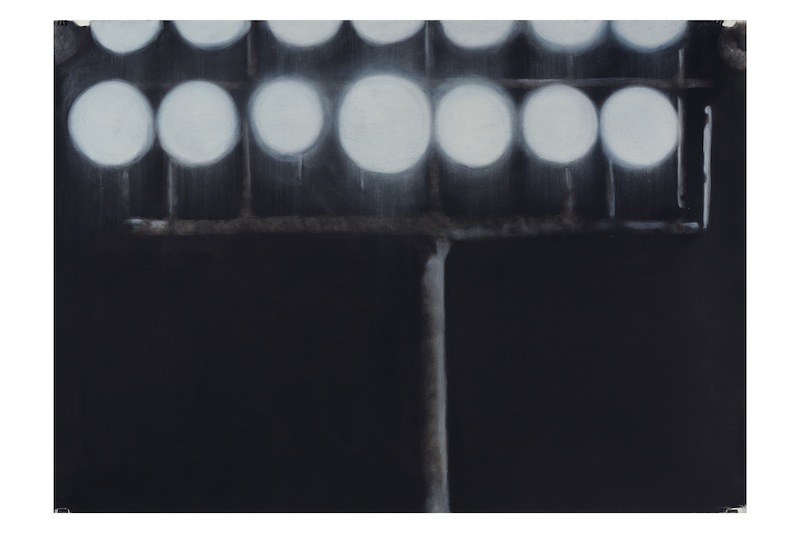
© » KADIST
Haig Aivazian
Drawing & Print (Drawing & Print)
This work is part of an ongoing project that looks at international sports competitions as a revealing element of nationalistic aspirations which present contradictions. The starting point of this work was inspired by private companies which were responsible for the security of the Olympic Games in England and also supply equipment for immigrant detention camps and prisons. This work questions the use of the stadiums other than for sports competitions.

© » KADIST
Wang Tuo
Tungus is the third chapter of The Northeast Tetralogy , a film project that Wang Tuo began in 2017. The project is a unique regional research of Northeastern China that addresses the region’s geopolitical contentions. Drawing on significant moments from China’s modern history, Wang’s visual storytelling sets up and displaces a series of socio-historical situations through multiple narrative structures.

© » KADIST
Lenora de Barros
Lenora de Barros’s poetics are known for setting in motion an intimate relationship between image and the written word. This was precisely one of the questions raised while producing the photographs that compose Poema , one of de Barros’s first and most iconic visual poems. The work consists of a sequence of six black and white photographs where language acts in a performative movement with the typewriter, forging a connection between word and image.

© » KADIST
Bunny Rogers
In Rogers’ Columbine works, the artist explores the 1999 high school shooting that took place in Littleton, Colorado, claiming 34 victims. Rogers’ Columbine projects have focused on understanding the shooters through delving into online forums for other teenagers (many of them girls) who identify and sympathize with them. Her two-channel video work, Poetry reading in Columbine Cafeteria with Gazlene Membrane & Poetry reading in Columbine Library with Joan of Arc , focuses on two characters: Gazlene Membrane and Joan of Arc.

© » KADIST
Jumana Manna
Blue Elbow (Coude bleu) is made from plaster, burlap, lacquer, pigments and plastics. The materials related to the techniques of the sculpture or the painting but also others, which refer to commerce, to objects of consumption. The chair refers directly to the body as does the title of the work, Blue Elbow .

© » KADIST
James T. Hong
Lessons of the Blood by James T. Hong pieces together interviews, extensive archival and field research, and TV footage addressing Japan’s use of biological warfare and experimentation on Chinese prisoners during World War II, as well as the revisionism of the Japanese government and Chinese survivors’ attempts to live with this horrific history and to find justice. Co-written, directed, edited and produced with Yin-Ju Chen, whose work is also represented in the Kadist collection, Lessons of the Blood is a meditation on propaganda, the ways in which national mythologies can literally infect and poison the most vulnerable among us, and the legacy of World War II in China, presented through the testimonies of survivors, academics, medical experts, nationalists and activists. The film locates its genesis in the publication of the New History Textbook in Japan in 2000, which infamously glossed over the Japanese Empire’s wartime atrocities, sparking rage and violent protests in China and South Korea in 2005.
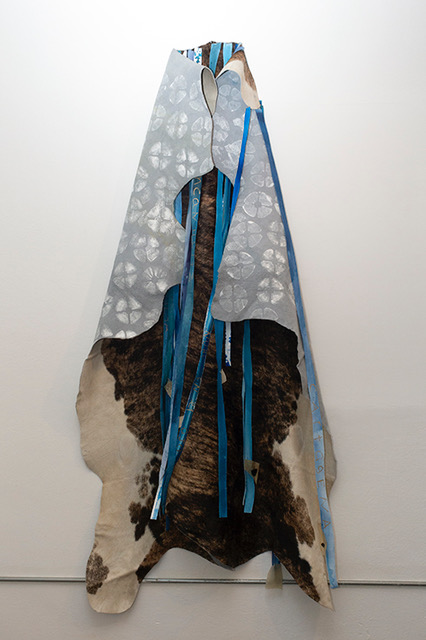
© » KADIST
Noé Martínez
As he investigates the forms that slavery took through different events that occurred during the sixteenth century in the Huasteca region of Mexico, Noé Martínez tells, in a non-linear narrative, the history of human trafficking in Relación de tráfico de personas 1525-1533 I (Study of Trafficking of Persons 1525–1533 I) . Both the departure of Huasteco Indians from the Americas, and the arrival of Africans from Cape Verde, Angola, Congo and Mozambique unravel in Martinez work as a story that has remained sealed in the colonial archives, and that continues under different guises in contemporary times. Relación de tráfico de personas 1525-1533 I is part of a series made of interventions in tanned leathers that refer to the exchange of human beings for pack animals and cattle in the Caribbean Sea.

© » KADIST
Nohemí Pérez
Drawing & Print (Drawing & Print)
A rich and isolated region, El Catatumbo is located near the border with Venezuela. Different groups fight over its gold and oil, while narcotic plantations have exploited the region over the years, provoking massacres, displacement, and migrations amongst its native populations. Nohemí Pérez’s skillful and eloquent watercolors, titled Apuntes para panorama Catatumbo , testifies to this aspect of Colombia’s history that has been veiled by other equally pressing political issues.

© » KADIST
Gabriel Borba Filho
Gabriel Borba Filho was aware of what was happening on the other side of the Atlantic, and Untitled (Nos) is linked to both the social and political climates in Brazil and Spain during the Franco period. The title Nos (Us) echoes this sharing of a situation of misfortune. He was particularly touched by the execution of Salvador Puig Antich, to whom this work pays homage, and also by the political assassination of one of his best friends.

© » KADIST
The Atlas Group
This image is an extract from a notebook in the archives of doctor Fakhouri that lists the cars that have been used for bombs between 1975 and 1991. Each page of the notebook contains a collage of an image of a car with the same make, model and color as the exploded car with a text in Arabic that gives the details of the place, time and date of the explosion, the number of people in the accident, the perimeter of destruction, the weight and the type of explosive. The images of the cars made visible are only equivalents since the cars that actually exploded are totally destroyed.

© » KADIST
Aslan Goisum
The video work Volga by Aslan Goisum begins with a sweeping field caught under a misty, gray sky. In the center of the frame is a white car of the eponymous Soviet make—standard-issue for the imperial administrative class during the USSR’s ‘Period of Stagnation.’ The vehicle is the only indication of cultural geography in the video; what unfolds must be somewhere in the former USSR. In a slow crescendo of activity and tension, small groups of men, women, and children, walk up to the car and squeeze into it.

© » KADIST
Ibro Hasanovic
Note on Multitude is a chilling black-and-white short movie recorded with a single camera in Prishtina, Kosovo, in 2015. The film, beginning in an unidentifiable location, shows a large, bustling and anxious crowd. Soon, the viewer is privy to the setting: a bus station.

© » KADIST
Shay Arick
Part of a series of videos called LIFE, where Shay Arik videos that re-enact iconic journalistic photographs. As explained by the video’s title, the departure point for LIFE #1 is the iconic 1943 photograph published by Life magazine that captures Japanese officer Yasuno Chikao from the Imperial Japanese Navy as he raises his sword, seconds before publically beheading Australian war commando Leonard Siffleet in the shores of Papua New Guinea. In Arick’s restaging there are no onlookers in the scene, the only two figures represented are Chikao and Siffleet: the perpetrator and victim of this fatal act of violence.

© » KADIST
Brook Andrew
This year: missing witness by Brook Andrew consists of a multi-layered collage of photographs. The work features newspaper cut-outs of the phrases: “This year: be prepared…” and “missing witness” overlaid onto a disaster scene, upon a worn-up manuscript. Pulled from The New York Times , the image is of a destroyed temple on the Indonesian island of Sulawesi, that has increasingly experienced natural disasters due to climate change.

© » KADIST
Jorge de León
Jorge de León most well-known work was a radical gesture, and one of his earliest artworks: in his 2000 performance, The Circle, de León sewed his own mouth closed as a protest against the silencing of citizens in the face of social corruption. His Cristal series is more demure, but follows a similar theme. In these works, delicate, web-like lines emerge against dark backgrounds, creating orbs of negative space, pitch black.

© » KADIST
Nikita Kadan
Drawing & Print (Drawing & Print)
Ukraine is under tension due to the politics of President lanoukovitch since 2010. Numerous passive demonstrations against the government have led to numerous police repression of the protestors. The demonstration ‘Euromaïdan’ in 2013 is a perfect example.

© » KADIST
Jesse Krimes
Raybrook by Jesse Krimes takes its name from The Federal Correctional Institution, Ray Brook (FCI Ray Brook), a medium-security United States federal prison for male inmates located in Essex County, NY. In addition to its indexical title, this quilt-work tapestry is made from personal clothing and other like articles the artist was given by currently, and formerly incarcerated persons. It is part of a larger series of works called the Elegy Quilts , which illustrate domestic scenes inspired by conversations the artist has had with the individuals these fabrics were acquired from.

© » KADIST
Martha Colburn
Martha Colburn’s film, Western Wild … or How I Found Wanderlust and Met Old Shatterhand , about the famed German author Karl May weaves together a mixture of stop motion animation, travelogue and biography that generates a kind of sensory wanderlust. Conflating past and present, the film investigates issues of identity and representation, as well as violence and war. The artist considers imagination as an invitation to dream, in order to disrupt the limitations of the everyday context and widen her viewers’ horizons.

© » KADIST
Claudia Joskowicz
Los rastreadores is a two-channel video by Claudia Joskowicz narrating the story of a fictitious drug lord, Ernesto Suarez, whose character is based on the well-known Bolivian drug dealer, Roberto Suárez. In the video, Suarez returns home from prison and survives a massacre that takes place at his home in Bolivia. Told in four chapters, the story is inspired by John Ford’s American Western classic film The Searchers (1956), this work similarly focuses on the politicized atmosphere of Bolivian history, searching for cues of race and alienation.
Wang Tuo
Through film, performance, painting, and drawing, artist Wang Tuo interweaves disparate realities through archives, modern history, myth, and literature...
Claudia Joskowicz
Claudia Joskowicz is a video and installation artist working at the intersection of landscape, history, and memory...
Prabhakar Kamble
Prabhakar Kamble is an artist, curator, and cultural activist...
Nikita Kadan
Trained in large-scale painting, Nikita Kadan’s artistic practice encompasses installation, graphics, painting, wall drawing, and urban postering, sometimes in collaboration with architects, human rights activists, and sociologists...
Reza Aramesh
Working across a wide range of materials and processes, Aramesh examines simultaneously the history of Western art and contemporary commentary on the politics and history of the Middle East, concocting a unique visual language to address the contemporary conditions of violence and bio-politics...
Pratchaya Phinthong
Pratchaya Phintong’s works often arise from the confrontation between different social, economic, or geographical systems...
Mona Marzouk
Mona Marzouk is an artist whose practice is deeply rooted in a keen sense for architecture...
Helina Metaferia
Helina Metaferia is an interdisciplinary artist working across collage, assemblage, video, performance, and social engagement...
Maya Watanabe
Drawing on her background in theater design and direction, Maya Watanabe is known for her multi-channel video installations that explore the relationship between language, collectivity, identity, and space...
James T. Hong
James T...
Manuel Correa
Manuel Correa’s practice deals with the reconstruction of post-conflict intergenerational memory in contemporary societies...
Kelley Walker
- location: Columbus, United States
- year born: 1969
- gender: male
- nationality: American
Christian Nyampeta
Christian Nyampeta’s works investigate how individuals and communities negotiate forms of socially-organized violence...
Dana Kavelina
Dana Kavelina is an artist and activist who works with video, animation, painting, illustration, and text...
Orion Shepherd
Orion Shepherd is a Los Angeles based artist working across drawing, collage, painting and sculpture...
Emmanuel van der Auwera
Emmanuel van der Auwera is interested in conspiracy theories, surveillance photography and its ubiquity, giving texture to major events that are frequently smoothed out by media reporting...
Maryam Hoseini
Maryam Hoseini makes delicate, figurative paintings to investigate the political, social, and personal conditions of identity and gender...
Majd Abdel Hamid
Palestinian artist Majd Abdel Hamid’s work is akin to an archeology of violence and trauma from which he unearths the materials that weave a web of new imagination...
Sarah Navqi
Sarah Naqvi works with art-focused activism and material realities...
Jesse Krimes
Jesse Krimes is an artist, curator, educator, former inmate, and activist whose work tackles and fights the US prison-industrial complex...
Christine Rebet
Taking formal cues from the optical illusions and landscapes drawn in pre-cinematic entertainment, French artist Christine Rebet seeks to unveil the way these kinds of devices are mirrored in contemporary politics and media...
Lenora de Barros
Lenora de Barros studied linguistics and started her artistic career in the 1970s...
Arin Rungjang
Arin Rungjang’s practice is known to revisit historical and political narratives, both major and minor, as a means to consider the past, present and future...
Eamon Ore-Giron
Eamon Ore-Giron’s paintings, works on paper and installations blend contemporary graphic design, folk and tourist art, and surrealism in a hybridity of Mexican, South American, Native-American, and other American cultures...
Aziz Hazara
Aziz Hazara works across various media such as video installation, photography, sound, and sculpture...
Haig Aivazian
Haig Aivazian is an artist and a writer, born in 1980 in Beirut and currently based there...
Martha Colburn
Martha Colburn is known for hand-made animations, which she creates through puppetry, collage, and paint-on-glass techniques...
Sheelasha Rajbhandari
Sheelasha Rajbhandari is a visual artist, cultural organizer, and co-founder of the artist collective Artree Nepal (founded in 2013) based in Kathmandu...
-
1970-1979
Luis Pazos
1971La Cultura de la Felicidad (The Culture of Happiness) is a series of five photographs addressing everyday life—a couple in a bed, lovers on a bench and a family reunion...
Gabriel Borba Filho
1975Gabriel Borba Filho was aware of what was happening on the other side of the Atlantic, and Untitled (Nos) is linked to both the social and political climates in Brazil and Spain during the Franco period...
-
1990-1999
The Atlas Group
1991This image is an extract from a notebook in the archives of doctor Fakhouri that lists the cars that have been used for bombs between 1975 and 1991...
John Baldessari
1997In One Must , an image of a pair of scissors, accompanied by the words of work’s title, poses an ominous question about the relationship between the image and the text...
Collier Schorr
1999Collier Schorr’s prints upend conventions of portrait photography by challenging what it means to “document” a subject...
-
2000-2009
Zarina Bhimji
2001Born in Uganda of Indian descent, Bhimji has lived in London after her family sought refuge from the regime of Idi Amin who compulsorily expelled all Asians from Uganda...
Kota Ezawa
2002The Simpson Verdict is a three-minute animation by Kota Ezawa that portrays the reading of the verdict during the OJ Simpson trial, known as the “most publicized” criminal trial in history...
Alain Séchas
2003A cat, standing like a human being, is looking at us with round and dazed eyes and holds a gun...
Sue Williamson
2003In her 2003 series “Better Lives”, Sue Williamson explores stories of immigrants in search of a better life in a historically contentious South Africa...
Nathalie Djurberg
2004Apparently Djurberg’s mother made a puppet theater and traveled around Göteborg performing during her childhood...
Pavel Wolberg
2004A young settler girl, dressed in a bridal outfit for Purim, stands in a street in Hebron waiting, perhaps for her parents or other children to join her...
Kelley Walker
2004The triptych Black Star Press is part of the series ‘The Black Star Press project’ initiated in 2004 by the American artist Kelley Walker...
Jennifer Locke
2005Choke documents the artist filming a wrestler “choking out” his teammate until he is unconscious...
Kara Walker
2005In her masterpiece 8 Possible Beginnings or The Creation of African-America , Walker unravels just that, the story of struggle, oppression, escape and the complexities of power dynamics in the history following slave trade in America...
Felipe Dulzaides
2006I Am Cuba— “Soy Cuba” in Spanish; “Ya Kuba” in Russian—is a Soviet/Cuban film produced in 1964 by director Mikhail Kalatozov at Mosfilm...
Ruijun Shen
2006In Seven Deadly Sins (2006), Shen utilizes abstraction to produce complex topographies of color that evoke associations with violently tumultuous landscapes...
Alejandro Marré
2007Typical Weapons is a series of sculptural interventions where Alejandro Marre transforms traditional Guatemalan craft objects usually sold as souvenirs into weapons...
Claudia Joskowicz
2007The primary interest in the trilogy is Joskowicz’s use of cinematic space, with long tracking shots that portray resistance to habitual viewing experiences of film and television...
Jazmín López
2008Shot on 35mm in two simply framed shots, Jazmín López’s Juego Vivo captures children at play, mixing imagination, reality, innocence, and violence...
-
2010-2019
Orion Shepherd
Drawing & Print
2010(Drawing & Print) Ballad of the Unabomber Part I is a painting by Orion Shepherd that features several manila folders stacked in order according to their size, resting atop a grainy hardwood pattern...
Taiki Sakpisit
2011A Ripe Volcano , a collaboration with Yasuhiro Morinaga, revisits two sites of violence and aggression in Thailand’s recent past: The Rattanakosin Hotel, the site where the military troops captured and tortured the civilians, students and protestors who were hiding inside the hotel during the Black May of 1992; and Ratchadamnoen Stadium, a Roman amphitheater-style Muay Thai boxing arena, which was built in 1941-45 during the Second World War and since then has become the theatrical labyrinth for more acculturated and commercially “acceptable” displays of bloodshed...
Eamon Ore-Giron
2011Eamon Ore-Giron’s new commissioned video project Bite Work, is an experimental genre breaking video that is part-performance, part-conceptual and part-comical addressing issues of mediation, surveillance and trust...
James T. Hong
2012Taiwan WMD (Taiwan and Weapons of Mass Destruction) is part of a long-term research started in early 2010 on the history and aftermath effects of Japanese biological and chemical warfare in China during WWII, as well as the unknown history of Taiwan’s nuclear program...
Tuan Andrew Nguyen
2012This work presents the image of an immolated monk engraved on a baseball bat...
Nalini Malani
2012Malani draws upon her personal experience of the violent legacy of colonialism and de-colonization in India in this personal narrative that was shown as a colossal six channel video installation at dOCUMENTA (13), but is here adapted to single channel...
Dawoud Bey
2012On 15 September 1963 members of the Ku Klux Klan blew up the 16th Street Baptist Church in Birmingham Alabama up using dynamite...
Sharif Waked
2012Bath Time by Sharif Waked is a short video based on the tragi-comic outcome of the Israeli Blockade and the wars in Gaza...
Haig Aivazian
Drawing & Print
2013(Drawing & Print) This work is part of an ongoing project that looks at international sports competitions as a revealing element of nationalistic aspirations which present contradictions...
Shay Arick
2013Part of a series of videos called LIFE, where Shay Arik videos that re-enact iconic journalistic photographs...
Nikita Kadan
Drawing & Print
2013(Drawing & Print) Ukraine is under tension due to the politics of President lanoukovitch since 2010...
Phan Thao Nguyên
2013On September 22, 1940 the French signed an accord, which granted Japanese troops the right to occupy Indochina...
Igor Grubic
2013The installation “East Side Story” is based on events that took place in the streets of Belgrade in 2001 and Zagreb in 2002, during the Gay Pride demonstrations, where the participants were the victims of verbal and physical injury by neo-Nazi groups and other citizens...
Nikita Kadan
Drawing & Print
2013(Drawing & Print) Ukraine is under tension due to the politics of President lanoukovitch since 2010...
Regina José Galindo
2013In 2012, former Guatemalan President José Efran Ros Montt was charged with genocide and crimes against humanity; Regina José Galindo’s video Tierra is a chilling reimagining of the atrocities recounted during his trial...
Claudia Joskowicz
2014Los rastreadores is a two-channel video by Claudia Joskowicz narrating the story of a fictitious drug lord, Ernesto Suarez, whose character is based on the well-known Bolivian drug dealer, Roberto Suárez...
Mona Marzouk
2014Trayvon is a series of acrylic paintings by Mona Marzouk that engages the courtroom as its points of departure...
Bunny Rogers
2014In Rogers’ Columbine works, the artist explores the 1999 high school shooting that took place in Littleton, Colorado, claiming 34 victims...
Maya Watanabe
2014In Escenarios (Sceneries) Maya Watanabe films forgotten wastelands through a series of 360° camera movements that highlight the dramatism and visual richness of terrain that would be otherwise forgotten...
Hank Willis Thomas
Drawing & Print
2014(Drawing & Print) Shot in black and white and printed on a glittery carborundum surface, Black Hands, White Cotton both confronts and abstracts the subject of its title...
Teresa Margolles
2014Stretching between San Pedro and the beach in Altata, Sinaloa, there is a 40 km road where there are three invisible borders controlled by rivalling armed groups...
Jesús Hdez-Güero
2014Minutos de odio contra sí mismo (Minutes of hate against itself) is a simple and powerful work about the political situation in Venezuela, replacing the stars on the flag with bullet holes...
Mona Marzouk
2014Trayvon is a series of acrylic paintings by Mona Marzouk that engages the courtroom as its points of departure...
Aslan Goisum
2015The video work Volga by Aslan Goisum begins with a sweeping field caught under a misty, gray sky...
Ibro Hasanovic
2015Note on Multitude is a chilling black-and-white short movie recorded with a single camera in Prishtina, Kosovo, in 2015...
Jorge de León
2015Jorge de León most well-known work was a radical gesture, and one of his earliest artworks: in his 2000 performance, The Circle, de León sewed his own mouth closed as a protest against the silencing of citizens in the face of social corruption...
Jumana Manna
2015Blue Elbow (Coude bleu) is made from plaster, burlap, lacquer, pigments and plastics...
Christine Rebet
2015In the Soldier’s Head evokes the traumas of war through the prism of the hallucinations of a soldier...
Claudia Joskowicz
2015Some Dead Don’t Make a Sound (Hay muertos que no hacen ruido) is a single-channel video by Claudia Joskowicz that features the Mexican legend of the Weeping Woman (La Llorona) as its main protagonist...
Nohemí Pérez
Drawing & Print
2016(Drawing & Print) A rich and isolated region, El Catatumbo is located near the border with Venezuela...
Uriel Orlow
2016The series The Memory of Trees is specifically about trees, and what trees have witnessed in South Africa: for example, trees that were used as locations for slave trading, or trees that was during the anti-Apartheid struggle as a kind of identifier for a safe house for activists who were fleeing from security forces...
Reza Aramesh
2016The photographed plaster heads set against the idyllic landscapes of the south of England, subvert the process of image production and memory...
Lawrence Abu Hamdan
2016In May 2014, Israeli soldiers shot and killed two teenagers, Nadeem Nawara and Mohamad Abu Daher in occupied Palestine (West Bank)...
Titus Kaphar
2016Although the objects depicted in Titus Kaphar’s diptych 2016/1963 might not be immediately recognizable, the work’s title and the inscriptions ‘Alabama 1963’ and ‘North Dakota 2016’ reveal their use as tools of brutal force...
Reza Aramesh
2016The photographed plaster heads set against the idyllic landscapes of the south of England, subvert the process of image production and memory...
Joaquín Segura
2016Pyre , an installation by Mexico City-based artist Joaquín Segura, addresses corruption, impunity, and the role that failed governments play in the normalization of violence...
Martha Colburn
2017Martha Colburn’s film, Western Wild … or How I Found Wanderlust and Met Old Shatterhand , about the famed German author Karl May weaves together a mixture of stop motion animation, travelogue and biography that generates a kind of sensory wanderlust...
Imran Qureshi
2017At first glance, This Day by Imran Qureshi appears to be an energetic, gestural painting reminiscent of Action Painting from the mid-20th century...
Colectivo Los Ingrávidos
2017The word Coyolxauhqui refers to femicide or the killing of women in rural Mexico on the basis of gender...
Santiago Yahuarcani
Drawing & Print
2017(Drawing & Print) The series Castigos del caucho by Santiago Yahuarcani originates in the oral memory transmitted by the artist’s grandfather, who was a survivor of the Putumayo genocide where thousands of Indigenous people were annihilated and enslaved to extract rubber from the Amazon forest between 1879 and 1912...
Michael Rakowitz
2017The Ballad of Special Ops Cody by Michael Rakowitz is a serio-comic stop motion animated film in which an everyday African-American G...
Lungiswa Gqunta
2017Feet Under Fire by Lungiswa Gqunta depicts the artist’s lower legs swinging in and out of frame, above a bed of charcoal...
Jorge Julián Aristizábal
Drawing & Print
2017(Drawing & Print) La Masacre de el Aro (The Massacre of El Aro) by Jorge Julián Aristizábal refers to a massacre in Colombia which occurred on October 22, 1997 in the municipality of Ituango, Department of Antioquia...
Arin Rungjang
2017246247596248914102516… And then there were none narrates a semi fictional account centered around the ambiguous history of the Democracy Monument in Bangkok, and on the aftermath of the 1973 demonstration of 400,000 people who marched against the military junta from Thammasat University to the monument...
Kathy Jetnil-Kijiner
2018Anointed by Kathy Jetnil-Kijiner and Dan Lin is a poem recital/video that addresses the American nuclear testing legacy in the Marshall Islands that occurred between 1946 to 1958 in Bikini and Enewetak Atolls...
Christian Nyampeta
2018The film Sometimes It Was Beautiful by Christian Nyampeta poetically addresses the systemic conditions leading and emerging from the 1994 Rwandan genocide, which had lasting and profound effects on Rwanda and neighbouring countries like Congo...
Frida Orupabo
2018The archival images used by Frida Orupabo in her collages trace stereotyped representations of race, gender, sexuality and violence...
Manuel Correa
2018La Forma del Presente (The Shape of Now) by Manuel Correa follows a group of survivors of Colombia’s 50-year long armed conflict facing the impossible task of agreeing on a shared past...
Sheelasha Rajbhandari
2018Agony of the New Bed by Sheelasha Rajbhandari brings out the familiar yet often ignored reality of gender discrimination and taboos built within the construct of marriage...
Nikita Kadan
Drawing & Print
2018(Drawing & Print) East of Ukraine became a place of armed conflict with Russia-backed separatists, who proclaimed parts of (the) Donetsk and Lughansk oblast (administrative region in Ukrainian) to be ‘People’s republics’...
Jota Mombaça
2018The performance title A Gente Combinamos De Não Morrer (BANDEIRA #1) / Us Agreed Not To Die (FLAG #1) is taken from a short story by Brazilian writer Conceição Evaristo, whose work addresses violence, resilience, and necropolitics with an Afro-diasporic lens...
Walead Beshty
2018Office Work by Walead Beshty consists of a partially deconstructed desktop monitor screen, cleanly speared through its center onto a metal pole...
Native Art Department International
2018The neon sign Walk the Walk (Sam Durant) overlays a Walk/Don’t Walk Sign crosswalk sign onto the text “You Are On Indian Land Show Some Respect.” The sign asks viewers to not walk on Indigenous lands without respecting it, and, switching between a walking person icon in white and a raised hand icon in red, redirects their actions...
Chitra Ganesh
2018Silhouette in the Graveyard is part of a suite of animated videos by Chitra Ganesh titled The Scorpion Gesture ...
Indira Allegra
2018Open Casket IX is an installation by Indira Allegra that combines traditional materials of memorial—tombstones, mausoleums, and caskets—with contemporary expressions of grief...
Sarah Navqi
2019A “mata ni pachedi” is a piece of painted textile that depicts narrative images of goddesses...
Noé Martínez
2019As he investigates the forms that slavery took through different events that occurred during the sixteenth century in the Huasteca region of Mexico, Noé Martínez tells, in a non-linear narrative, the history of human trafficking in Relación de tráfico de personas 1525-1533 I (Study of Trafficking of Persons 1525–1533 I) ...
Emmanuel van der Auwera
2019Emmanuel van der Auwera visited Miami at the end of 2017 and was working on a project relating to school shootings...
Majd Abdel Hamid
2019Tadmur by artist Majd Abdel Hamid is influenced by a book by Mustafa Khalifa titled The Shell: Memoirs of a Hidden Observer , which details Khalifa’s imprisonment in the Assad ‘desert prison’ Tadmur...
Ana María Millán
2019Interested in role-play and videogames, Ana María Millán developed workshops with different communities in order to create characters and scenarios for her animations, often in collaboration with a choreographer...
Sancintya Mohini Simpson
Drawing & Print
2019(Drawing & Print) And words were whispered by Sancintya Mohini Simpson is a series of ten works on paper based on the lived experiences of Indian women taken to the Natal region of South Africa from the 1860s to the early 1900s to work in tea and sugarcane plantations during apartheid, which included servitude in its broadest and most sinister definition...
Park Chan-Kyong
2019Park Chan-Kyong’s otherworldly film Belated Bosal primarily follows two women as they navigate their way up a spectral mountain and through what appears to be a history museum or nuclear disaster bunker...
American Artist
2019From suicides, to gang violence, to the epidemic abuse of force by police departments (predominantly against Black men), to school and mass shootings, there is perhaps no more urgent issue in the United States than gun control...
Maryam Hoseini
2019Secrets Between Her and Her Shadow 10 by Maryam Hoseini is from a series of paintings of the same title that are inspired by the story Layla and Majnun – an Arabic love story about Majnun, a 7th century Bedouin poet, and his lover, Layla...
Shubigi Rao
2019Named after a book that artist Shubigi Rao read growing up, The Yellow Scarf explores the history of the Thuggee cult in India in relation to the colonial British administration that ‘discovered’ but also ultimately exterminated this cult of assassins...
Helina Metaferia
2019By Way of Revolution is a series of works by Helina Metaferia that addresses the inherited histories of protest that inform contemporary social movements...
-
2020-2029
Brook Andrew
2020This year: missing witness by Brook Andrew consists of a multi-layered collage of photographs...
Jesse Krimes
2020Raybrook by Jesse Krimes takes its name from The Federal Correctional Institution, Ray Brook (FCI Ray Brook), a medium-security United States federal prison for male inmates located in Essex County, NY...
Runo Lagomarsino
2020Yo también soy humo (I am also smoke) is a 16mm film that has been digitized to video...
Manuel Correa
2020Manuel Correa’s documentary Four Hundred Unquiet Graves is a powerful and vulnerable visual essay about the descendants of those who were disappeared during the Spanish Civil War from 1936–1939...
rafa esparza
2020thanks for staying alive Fern.1994 by rafa esparza is from a body of work that pays homage to youth culture in the 90s...
Dana Kavelina
2020Letter to a Turtledove by Dana Kavelina is a short film based on a poem written by the artist...
Pichet Piaklin
2021The Wings by Pichet Piaklin is a creation story of fragility, where the desire for freedom is mired in blood red by the inculcation of faith and violence...
Maya Watanabe
2021Maya Watanabe’s video installation Bullet unfolds within the context of the Peruvian justice and forensic systems...
Lenora de Barros
2021Lenora de Barros’s poetics are known for setting in motion an intimate relationship between image and the written word...
Daniela Ortiz
2021The Rebellion of Roots by Daniela Ortiz depicts a series of situations in which tropical plants, held hostage in the botanical gardens and greenhouses of Europe, are protected and nurtured by the spirits of racialized people who died as a result of European racism...
Pratchaya Phinthong
2022Pratchaya Phinthong’s work has explored the mineral and karmic economies of Laos, a country that shares language, beliefs, and a long border with his own native region of Isaan (Northeast Thailand)...
Prabhakar Kamble
2022To produce the series of sculptures collectively titled Utarand , Prabhakar Kamble relocated his studio to Kolhapur, Maharashtra, near the village where he was born into a family of daily wage earners...
Prabhakar Kamble
2022To produce the series of sculptures collectively titled Utarand , Prabhakar Kamble relocated his studio to Kolhapur, Maharashtra, near the village where he was born into a family of daily wage earners...
Prabhakar Kamble
2022To produce the series of sculptures collectively titled Utarand , Prabhakar Kamble relocated his studio to Kolhapur, Maharashtra, near the village where he was born into a family of daily wage earners...
Pratchaya Phinthong
2022Pratchaya Phinthong’s work has explored the mineral and karmic economies of Laos, a country that shares language, beliefs, and a long border with his own native region of Isaan (Northeast Thailand)...
Helina Metaferia
2023By Way of Revolution is a series of works by Helina Metaferia that addresses the inherited histories of protest that inform contemporary social movements...






















